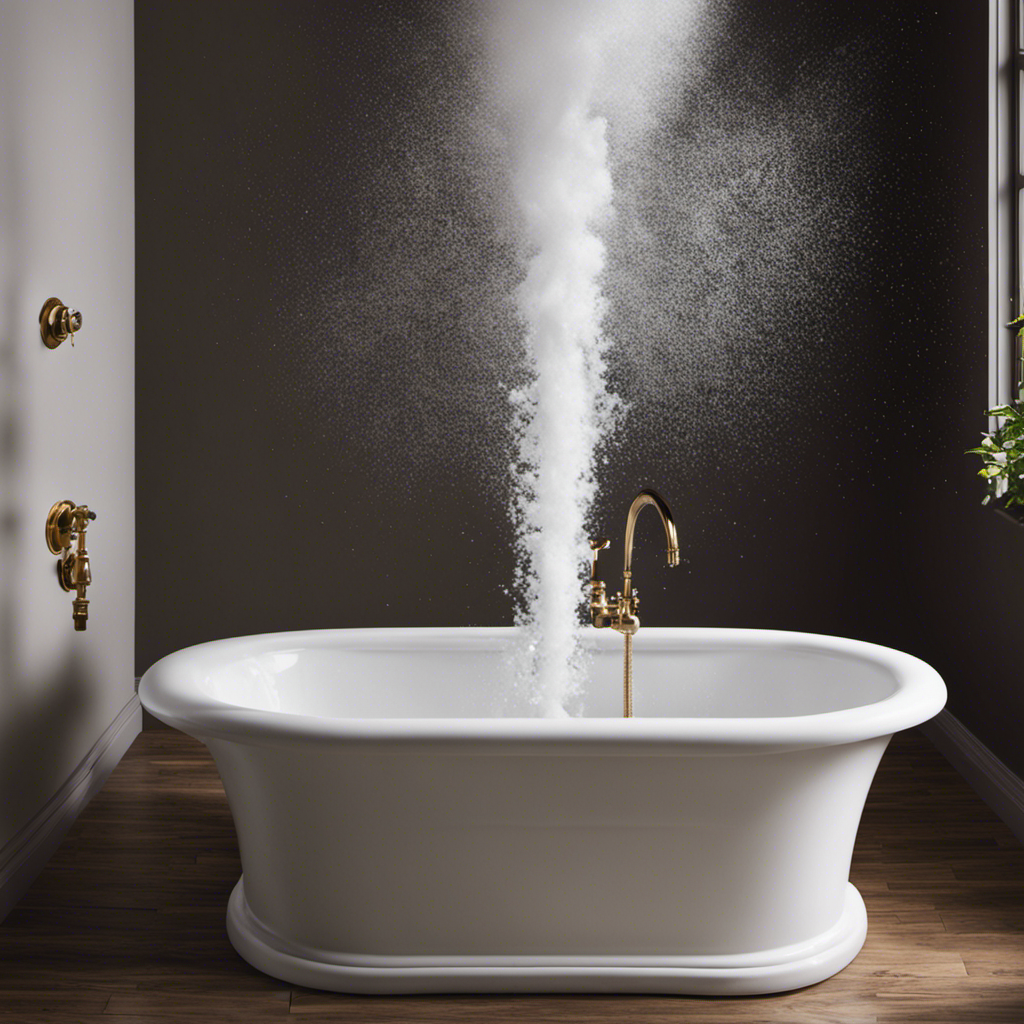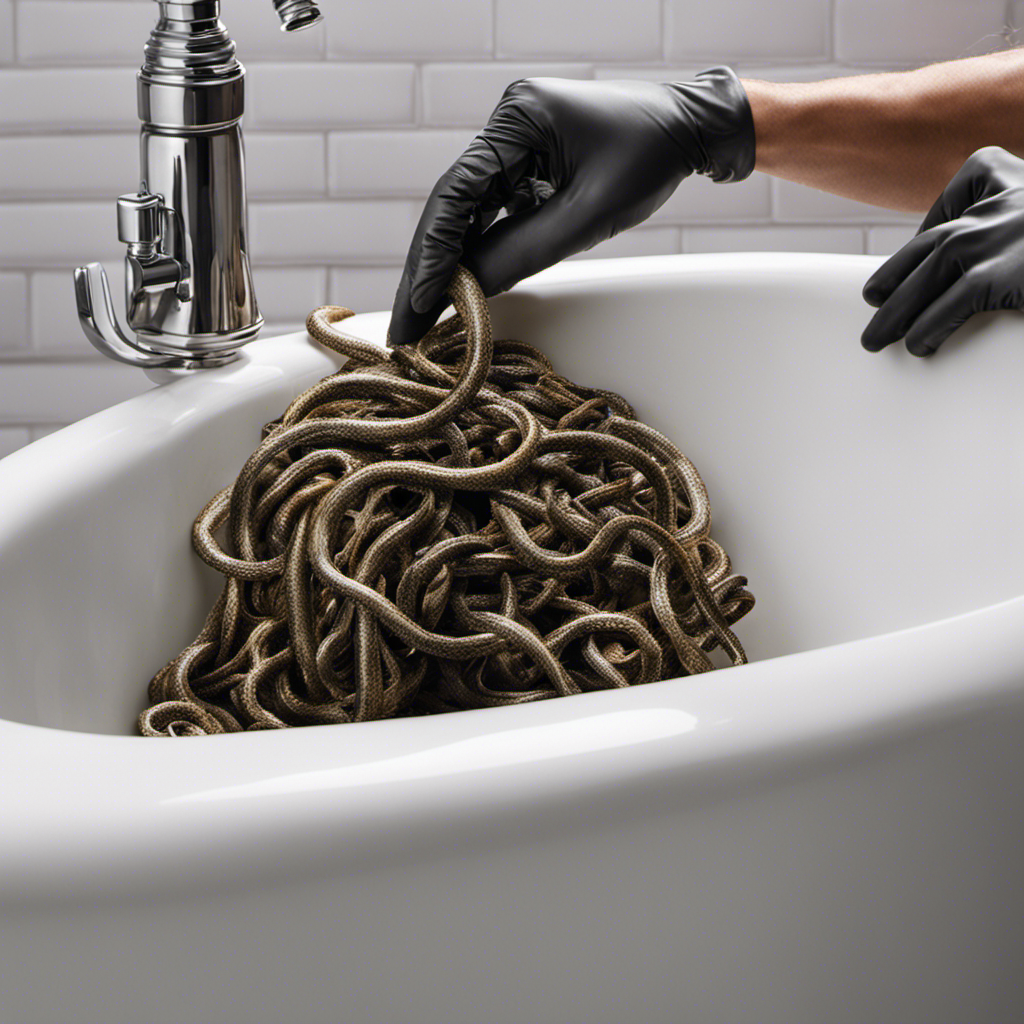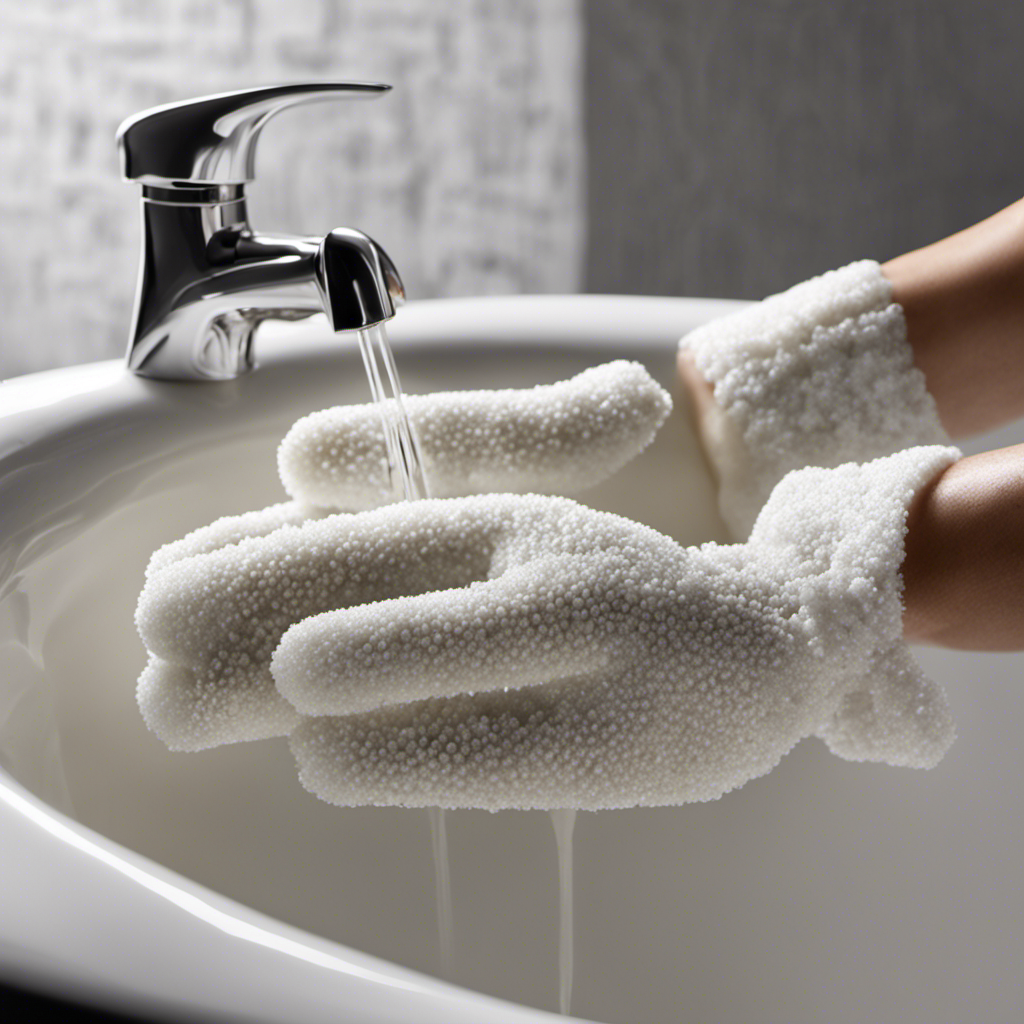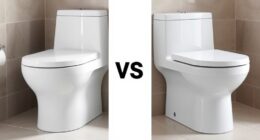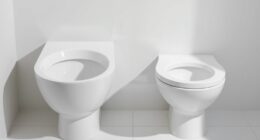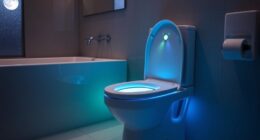Are you tired of dealing with a clogged bathtub drain? Don’t worry, there’s a solution that doesn’t require removing the stopper.
In this article, we’ll show you how to unclog your bathtub drain using simple techniques and everyday household items. You’ll learn how to assess the severity of the clog, gather the necessary tools, and remove any visible debris or hair.
Get ready to say goodbye to clogged drains and hello to a smoothly flowing bathtub!
Key Takeaways
- Hair, soap scum, and small objects are common causes of bathtub drain clogs.
- Different types of clogs require specific drain cleaner options such as baking soda and vinegar for hair clogs, boiling water and salt for soap scum clogs, and baking soda and lemon juice for grease clogs.
- Effective hair removal techniques, including using a drain snake, are important for clearing visible blockages and ensuring proper water flow.
- Regular preventive maintenance, such as removing hair and debris from the drain and using homemade drain cleaners, can help avoid future blockages.
Assess the Severity of the Clog
Before attempting any unclogging methods, it’s important to assess the severity of the clog in your bathtub drain. This will help you determine the most appropriate course of action to take.
Severity assessment involves examining the level of blockage and understanding its common causes. There are several factors that contribute to clogs in bathtub drains, such as hair buildup, soap scum, and foreign objects.
Hair is one of the primary culprits, as it easily gets trapped in the drain and combines with other substances to form a stubborn clog. Soap scum can also accumulate over time, further restricting water flow. Additionally, small objects like jewelry or toiletries accidentally dropped into the drain can cause blockages.
Gather Necessary Tools and Materials
First, you’ll need to get the tools and materials necessary for the task at hand. To unclog your bathtub drain without removing the stopper, you can use alternative drain cleaners. These cleaners are typically less harsh than chemical-based cleaners and are more environmentally friendly. Before choosing a drain cleaner, it’s important to understand the different types of clogs you may encounter. Here is a table that provides a visual representation of the different types of clogs and the corresponding drain cleaner options:
| Type of Clog | Drain Cleaner Options |
|---|---|
| Hair clogs | Baking soda and vinegar |
| Soap scum clogs | Boiling water and salt |
| Grease clogs | Baking soda and lemon juice |
Remove Any Visible Debris or Hair
When it comes to maintaining a clean and functioning drain, there are a few key points to keep in mind.
First, you’ll want to familiarize yourself with effective hair removal techniques, as hair is often the main culprit behind clogged drains.
Additionally, clearing visible blockages is crucial in preventing further buildup and ensuring proper water flow.
Hair Removal Techniques
To remove hair from your bathtub drain without removing the stopper, you can try using a drain snake or a mixture of baking soda and vinegar. Hair removal products are available in the market, but natural hair removal methods can be just as effective. Here is a comparison of the two methods:
| Hair Removal Products | Natural Hair Removal Methods |
|---|---|
| Chemical-based | Chemical-free |
| Quick results | May take longer |
| May contain harsh ingredients | Gentle on the skin |
| Convenient to use | Requires preparation |
| Can be expensive | Cost-effective |
Hair removal products often contain chemicals that can irritate the skin, while natural methods, like using baking soda and vinegar, are gentle and safe. However, natural methods may take longer to show results. Now, let’s move on to the next section and learn how to clear visible blockages in your bathtub drain.
Clearing Visible Blockages
Using a plunger is an effective method for clearing visible blockages in your tub. Here are three reasons why you should consider using this technique:
-
Quick and Easy: With just a few plunges, you can dislodge hair and debris that may be causing the blockage. It requires minimal effort and can be done in a matter of minutes.
-
Cost-effective: Unlike other hair removal techniques or hiring a professional plumber, using a plunger is a cost-effective solution. You don’t have to spend money on expensive drain cleaners or services.
-
Safe and Environmentally-friendly: By using a plunger, you avoid the use of harsh chemicals that are often found in commercial drain cleaners. This makes it a safer option for you and the environment. Plus, you don’t have to worry about the potential damage these chemicals can cause to your pipes.
If the plunger method doesn’t work, you can try using a homemade drain cleaner as an alternative solution.
Preventive Maintenance Tips
One way you can prevent future blockages in your tub is by regularly removing hair and debris from the drain. This preventive maintenance task can save you the hassle of dealing with clogged drains in the future.
Hair is one of the most common causes of clogged drains, as it easily gets tangled and accumulates in the pipes. Additionally, other debris such as soap residue, grease, and small objects can also contribute to blockages.
Use a Homemade Drain Cleaner
You can easily unclog your bathtub drain without removing the stopper by using a homemade drain cleaner. Here are three homemade drain cleaner alternatives that you can try, along with the pros and cons of chemical drain cleaners:
-
Baking Soda and Vinegar: Mix equal parts of baking soda and vinegar to create a fizzy reaction that can help break down clogs. This method is environmentally friendly and safe for your pipes, but it may not be effective for severe clogs.
-
Salt and Hot Water: Mix one cup of salt with a few liters of hot water and pour it down the drain. The abrasive nature of salt can help remove grease and debris. However, it may not be as effective for hair clogs.
-
Boiling Water: Simply pour boiling water down the drain to dissolve minor clogs. This method is quick and easy but may not work for stubborn clogs.
When using chemical drain cleaners, consider the pros and cons. Chemical cleaners are often highly effective in removing tough clogs, but they can be harmful to your health and the environment. They may also damage your pipes over time. It’s important to follow the instructions carefully and use them sparingly.
Try Using a Plunger or Drain Snake
When it comes to unclogging a drain, you have two primary options: a plunger or a drain snake. Both methods have their pros and cons, and understanding their effectiveness can help you choose the right tool for the job.
In this discussion, we will compare the two methods and explore the different scenarios where each one excels, allowing you to make an informed decision and effectively tackle any clog.
Plunger Vs. Drain Snake
To unclog your bathtub drain without removing the stopper, there are two methods you can consider: using a plunger or a drain snake. Here’s a comparison between the two methods:
-
Plunger benefits:
- Quick and easy to use: A plunger creates suction, which helps dislodge clogs efficiently and effectively.
- Versatile: Plungers can be used on various types of drains, including sinks and toilets.
- Cost-effective: Plungers are inexpensive and readily available, making them a practical choice for regular maintenance.
-
Snake limitations:
- Requires skill: Using a drain snake requires some level of expertise to navigate through the pipes without causing damage.
- Limited reach: Drain snakes are typically shorter than plungers, making it difficult to reach deep clogs.
- Potential for mess: Snaking a drain can be messy, as it involves pulling out debris manually.
Effectiveness of Different Methods
The effectiveness of different methods for clearing clogs varies depending on the severity of the blockage. When dealing with a minor clog in your bathtub drain, alternative solutions such as baking soda and vinegar or hot water and dish soap can be effective. These methods work by breaking down the debris causing the clog and allowing it to be washed away.
However, for more stubborn and severe clogs, professional drain cleaning may be necessary. Professional plumbers have access to specialized tools and equipment, such as hydro-jetting or drain snakes, which can effectively clear even the toughest clogs.
It’s important to remember that prevention is key to avoiding future clogs. By regularly maintaining your drains, such as using drain screens and avoiding pouring grease down the drain, you can minimize the need for unclogging in the future.
Prevent Future Clogs With Regular Maintenance
You can prevent future clogs with regular maintenance by using a drain cover and cleaning it regularly. Here are three benefits of regular maintenance and the common causes of bathtub clogs:
-
Prevents hair and debris buildup: Regular maintenance, such as using a drain cover, helps to catch hair and other debris before it goes down the drain. This prevents clogs caused by the accumulation of these materials.
-
Maintains optimal water flow: By regularly cleaning the drain cover, you can ensure that water flows smoothly down the drain. This prevents slow drainage, which can lead to clogs over time.
-
Saves you time and money: Regular maintenance helps to prevent costly and time-consuming clogs. By taking proactive measures to keep your bathtub drain clear, you can avoid the hassle of dealing with clogs and the expense of hiring a professional plumber.
Frequently Asked Questions
Can I Use a Chemical Drain Cleaner Instead of a Homemade Drain Cleaner?
You can use a chemical drain cleaner instead of a homemade one, but there are pros and cons. Chemical cleaners are effective but can be harmful. Follow safety instructions, avoid contact, and properly dispose of them.
What Materials Do I Need to Gather for the Unclogging Process?
To unclog your bathtub drain without removing the stopper, gather a plunger, baking soda, vinegar, and hot water. Avoid using chemical drain cleaners, as they can be harsh and harmful to the pipes.
How Do I Prevent Future Clogs in My Bathtub Drain?
To prevent future clogs in your bathtub drain, effective maintenance techniques are necessary. Avoid common mistakes like pouring grease or hair down the drain. Regularly use a drain cover and clean it.
Can I Use a Plunger or a Drain Snake to Unclog a Bathtub Drain With a Stopper?
To unclog a bathtub drain with a stopper, try using plunger alternatives like a drain snake. If that doesn’t work, consider hiring professional drain cleaning services for a more thorough solution.
What Are Some Signs That Indicate the Severity of a Clog in a Bathtub Drain?
If you notice slow drainage, water backing up, or unpleasant odors coming from your bathtub drain, it’s a sign that the clog may be severe. Common causes include hair, soap scum, and mineral deposits. Professional drain cleaning may be necessary.
Conclusion
So there you have it, a simple and effective way to unclog your bathtub drain without removing the stopper.
By assessing the severity of the clog and gathering the necessary tools and materials, you can easily remove any visible debris or hair and use a homemade drain cleaner to clear the blockage.
If that doesn’t work, don’t worry! You can also try using a plunger or drain snake.
Remember, regular maintenance is key to preventing future clogs.
With these techniques, you’ll have a smoothly flowing bathtub drain in no time.
